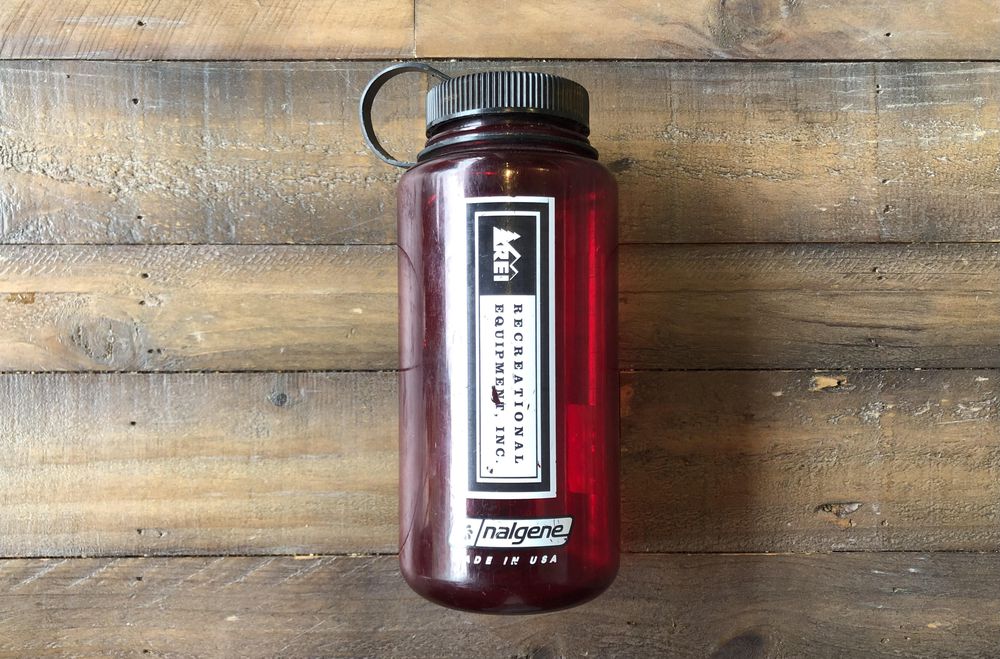Once a symbol of crunchy outdoorsy types, the reusable water bottle entered the mainstream in the early 2010s, when college campuses began to ban bottled water for environmental and health reasons. If that was the first wave of the reusable bottle trend — most were cheap, plastic, and simple — then the late 2010s marked another shift. The market pivoted to gargantuan stainless steel bottles from brands like Yeti, Hydro Flask, and ThermoFlask. These insulated giants are more premium, but they’re also heavier, expensive, and ultimately inferior when compared to the Nalgene water bottle.
Best Price: $16 from REI
Also Cheap: $16 from Amazon
Why I Love Nalgene Water Bottles
What is a water bottle for? Is it a container for hot drinks, a UV water purifier, a fashionable accessory, a status symbol? Call me old fashioned, but a water bottle should do one thing well: hold water. And that’s exactly what a Nalgene does best.
Thanks to its indestructible, light Tritan plastic, it’ll hold water — without leaking, denting, or breaking — for decades. Run it over with a van, fill it with boiling water, throw it off your roof — it doesn’t matter. Unless you come at it with a sledgehammer or a flamethrower, the Nalgene will survive (plus, it’s backed by a lifetime warranty).
Cleaning it is simple, too. Throw it in the dishwasher or rinse it out with some dish soap. Either way, most models have a wide mouth, so you don’t have to worry about buying a bottle brush or cleaning out grimy mouthpieces and straws. And the best thing about this indestructible, easy-to-clean bottle is that it’s dirt cheap. While prices vary depending on volume and color, many models sell for $16 or less.
Why You Might Not Want a Nalgene
My biggest gripe with Nalgenes is that they’re made of plastic. That’s a problem for two reasons. From an environmental angle, plastic is harmful because it releases a lot of greenhouse gasses and takes hundreds of years to begin decomposition. Plastics also have the potential to leach harmful chemicals, though Nalgenes are BPA and BPS-free.
This last point was particularly important to me, especially with all the terrifying news about microplastics coming out. Unfortunately, I didn’t love what I found when I dug a little deeper. Although I struggled to find data on microplastics and Nalgenes, I did find a 2014 study published in the Journal of Environmental Health that tested bottles for leaching. Researchers found that the blue Nalgene bottle tested positive formoderate levels of hormone-altering chemicals (similar to BPA) after being exposed to UV light. The good news is that green Nalgene bottles were free of these chemicals, even after being exposed to light, as green dye reportedly blocks UV rays. So if you’re worried about contaminants (like I am), stick with green Nalgenes, don’t let them sit too long in the heat and sun, or avoid them altogether.
Who Is This Product For?
If you want a practical, cheap, no-frills water bottle, you’ll love your Nalgene. The only dealbreaker for budget shoppers might be its plastic construction, which isn’t the healthiest or most sustainable option out there.
TLDR: Pros and Cons
Pros
Cheap
Easy to clean (dishwasher safe)
Wide mouth
Leakproof
Water remains flavorless
Nearly indestructible
Lightweight
Variety of sizes and colors
Cons
Plastic has the potential to leach chemicals
Plastic takes forever to decompose
Not insulated
Easy to spill because of wide mouth (Nalgene sells narrow-mouth models and an easy-sipper insert)
Doesn’t fit in cup holders
Evaluating the Competition
I’ll be honest. While I’ve owned a few metal bottles, including an off-brand Hydro Flask, I’ve generally avoided premium stainless steel and glass water bottles. That said, I’ve been around them enough to know why people love them, and I’ll admit that it’s nice to drink ice-cold water out of a giant, sturdy bottle. But at the end of the day, I’m someone who prefers ease and simplicity. For now, I’ll stick with Nalgene (and my off-brand stainless steel bottle).
The Bottom Line
Nalgenes appeal to thrifty consumers who want a simple, buy-it-for-life water bottle. Like other near-perfect products, you never have to think about a Nalgene. Apart from filling it up with water, throwing it in your bag, and washing it every once in a while, you'll forget you own it. But it’s not for everyone. If you want an insulated water bottle or prefer stainless steel and glass, you’ll be better off with a more expensive model from Yeti. Otherwise, I highly recommend buying a Nalgene, particularly the green one, in your preferred size (from 12 ounces to 48 ounces).
Our Review Process
I’ve owned over five Nalgenes over the past decade and have tested them in a variety of settings, from my college campus and gym to climbing crags and the high desert. Although I’ve misplaced several, I’ve never had one fail. And beyond testing the bottles, I’ve also done extensive research on water bottles, particularly when it comes to their environmental and health effects.
Frequently Asked Questions
Are Nalgenes dishwasher safe?
Yes. Just unscrew the cap and place it on the top rack.
How do you clean a Nalgene bottle?
Put it in the dishwasher or just wash it out with soap and water.
Are Nalgene bottles safe?
Nalgene bottles are generally safe, though consumers concerned about potential hormone-altering chemicals should buy the green bottle, which leaches fewer chemicals.
For more thorough product reviews, please sign up for our free newsletters.

 Photo credit: Cheapism / Maxwell Shukuya
Photo credit: Cheapism / Maxwell Shukuya







